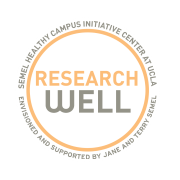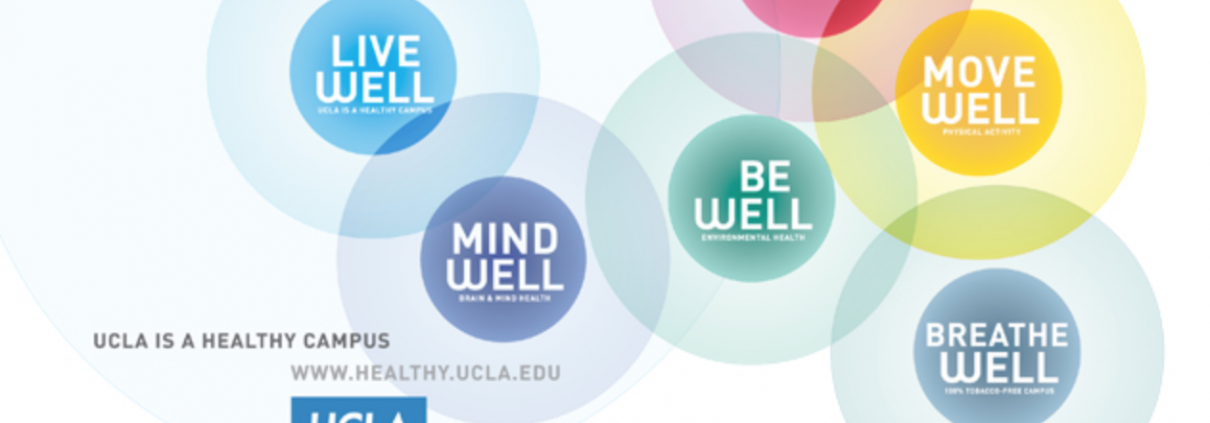Celebrating the Healthy Campus Initiative: Looking back and looking forward
UCLA is excitingly marking the fifth year of the presence of the Healthy Campus Initiative (HCI) on its campus. The initiative was officially launched by Chancellor Gene Block in January 2013, thanks to the vision, funding, support, and participation of philanthropists Jane and Terry Semel. In honor of this milestone, let’s take a look back at HCI’s beginnings and biggest accomplishments, as well as a look forward towards what’s on the horizon for HCI.
HCI began with the Semels’ vision to create a culture of living well on the UCLA campus — for students, staff, faculty, and the community. The goal was to cultivate a campus-wide wellness movement that would make UCLA the healthiest university campus in America, and to do it well in our own backyard such that others would be inspired to join the movement. To achieve this, the Semels worked with other key figures, including Chancellor Gene Block and Michael Goldstein, former assistant vice provost, to blend health promotion with the True Bruin values, creating a unique structure that has since served as the inspiration for other health movements, such as the UC Global Food Initiative and Michelle Obama’s Partnership for a Healthier America.
Dr. Wendy Slusser, assistant vice provost of HCI, emphasizes that HCI achieves a collective impact because it is a “coordinating structure emanating from the chancellor’s office that helps to catalyze and leverage the incredible wealth of resources and knowledge on [UCLA’s] campus.” HCI brings together stakeholders promoting physical, emotional, and social health and wellbeing, and connects them with academic departments researching and teaching related subjects such as environment, food, and life skills, as well as administrative units across campus including Dining Services, Transportation, and Recreation.
By bringing all these key players together, HCI helps to make the healthy choice the easiest choice for student, staff, and faculty. Furthermore, with its six distinct pods — MoveWell, MindWell, BEWell, EatWell, BreatheWell, and ResearchWell — HCI’s interdisciplinary approach to health and wellbeing allows it to continuously find new and innovative ways to promote health on campus.
Over the past four years, the initiative has seen many successes. From more bike lanes to an undergraduate food studies minor, a “Mindful Music” series to meditation drop-ins to a tobacco-free campus, HCI has improved UCLA’s campus in numerous ways. Dr. Slusser believes that part of HCI’s success comes from its location within the chancellor’s office. Because the chancellor oversees everyone at UCLA, even the health system, it is clear that HCI cares about everyone’s physical, emotional, and social health on campus. Furthermore, in acting as a coordinating structure, HCI embraces health initiatives already in the works on campus and connects them to the resources they need to succeed, all while giving credit where credit is due.
Another key component to making impactful change on campus was pairing faculty pod leaders with key members of UCLA staff. For example, the MoveWell pod is led by both Professor Angelia Leung and the head of UCLA Recreation Wendy Windsor, which enables the pod to take research and innovation from UCLA students, staff, and faculty and directly implement it on campus through UCLA Recreation. Similarly, the BEWell pod is led by both Professor Richard Jackson and Renee Fortier, executive director of UCLA Events and Transportation. The medicinal garden planted south of the Ronald Reagan Hospital as part of HCI is a visible example of an idea translated into reality through the interdisciplinary collaboration of the then CEO of the hospital David Feinberg, Professor Peter Whybrow, Jane Semel, and the volunteerism of the UCLA community.
When asked about what’s up next for the HCI, Jane Semel and Dr. Slusser remarked that it’s hard to predict future projects due to the collaborative and innovative nature of the Initiative. However, two big projects on the horizon include efforts to pull together all the mental health resources on campus, led by Dr. Bob Bilder, the faculty leader for the HCI BEWell pod and Professor in the Semel Institute, and the construction of a living amphitheater in the Sunset Recreation Center. Jane Semel conceived the idea of the amphitheater several years ago and brought in the support from the Chancellor, Alice Bamford and Anne Eysenring, of One Gun Ranch, Dean Teri Schwartz of the UCLA School of Theater, Film and Television, and Mick DeLuca, Assistant Vice Chancellor. Semel remarked that the upcoming living amphitheater is one of the projects she is the most proud of, as it will provide healthy food, exercise, stress-reduction, and the opportunity for community building to the UCLA community. The living amphitheater is expected to be finished in the spring and will be the location for the annual celebration of the Healthy Campus Initiative on May 4 called Dream Revolution where TFT students will perform a Midsummer’s Night Dream. As Jane Semel says: “It is a dream come true!”
What do you think have been some of the HCI’s biggest accomplishments or how has it allowed you to lead a healthier life on campus? Comment below or share your thoughts with us on Facebook!
Danielle de Bruin is a fourth-year undergraduate student at UCLA majoring in Sociology with a double minor in Italian and Global Health. She is the blog coordinator for the UCLA Healthy Campus Initiative and the director of UCLA’s Body Image Task Force, which is a committee within the Student Wellness Commission. With the Body Image Task Force, Danielle organizes events, workshops, and campaigns to promote healthy body image, self-confidence, and mental health on campus. She is also published in the journal PLOS Medicine and the Huffington Post.


